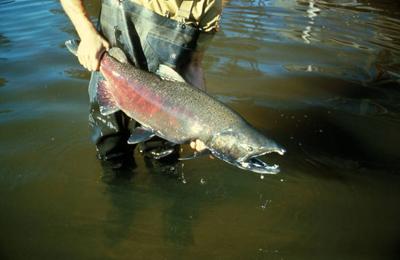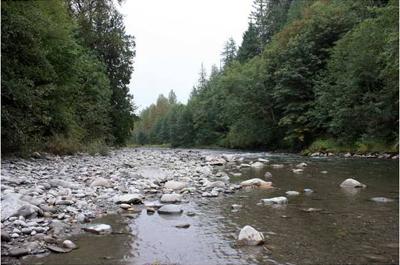EPA Science Matters Newsletter: Helping to Protect Wild Salmon (Published April 2014)
Published January 2014
EPA researchers and partners are working to help protect South Fork Nooksack River Watershed salmon from warming waters.
 Chinook salmon (Oncorhynchus tshawytscha). USFWS image.
Chinook salmon (Oncorhynchus tshawytscha). USFWS image.Chinook salmon in the Nooksack River watershed are ‘swimming’ against the threat of extinction due to rising water temperatures related to the effects of climate change and a historical loss of freshwater habitat, as well as other factors. Located in the state of Washington, the Nooksack River watershed is an important part of local culture and economy. It supports a vast diversity of wildlife and provides important habitat and spawning areas to the iconic Chinook salmon, one of the area’s most important cultural and economic resources.
But last year, a mere 200 adult Chinook salmon, out of an estimated population of 10,000 to 15,000, returned to the South Fork Nooksack River for the spring spawning season.
“The Nooksack Indian Tribe relies on salmon for subsistence, commercial, cultural, and ceremonial purposes,” Oliver Grah, water resources program manager of the Nooksack Indian Tribe, said. “The Tribe is an active part of the efforts to sustain salmon population in the face of climate change.”
A significant factor contributing to the decline is warming waters in the river. When waters warm beyond a relatively narrow temperature range where salmon thrive, it adds to stresses that ultimately reduce their population.
EPA scientists have joined forces with partners from local Native American communities (the Nooksack Indian Tribe and Lummi Nation), the Washington State Department of Ecology, the National Marine Fisheries Service and the U.S. Forest Service to explore ways to better understand the dynamics of the warming waters and help offer solutions to restore threatened salmon runs.
Rising water temperature is one of the consequences of the diminishing snowpack in the surrounding mountains, the South Fork Nooksack River’s main water source. Warmer winters the area has been experiencing have meant more rain and less snow at higher elevations, leaving less early season snowmelt to feed local watersheds. Compounding this, less rain during the summer diminishes river volumes, leaving what’s left more vulnerable to absorbing heat.
 Southfork of the Nooksack River
Southfork of the Nooksack RiverParts of the South Fork Nooksack River have been found to be several degrees warmer than water temperature criteria established and set to protect the “biological integrity” of its aquatic life under the Clean Water Act.
EPA researchers and their partners are conducting two environmental assessments on the South Fork Nooksack River to provide environmental managers and others with the information they need to make an impact on salmon populations and help them begin to recover.
In one assessment, researchers are using an ecological risk assessment framework to investigate stream temperature and the factors that can cause it to change. EPA scientists, together with partners from the University of Washington Climate Impacts Group, and contractor researchers from (from Tetra Tech) developed a way to account for the impacts of climate change on watershed hydrology and how those impacts may affect the salmon in the South Fork Nooksack River. They are also estimating how the restoration of trees and shading along the river might impact water temperatures under different scenarios in the future.
EPA Northwest Regional staff and science liaison Dr. Bruce Duncan and Washington TMDL program manager Laurie Mann were instrumental in the development of the EPA Region 10 Climate Change and TMDL Pilot.
The other assessment is a broad study of climate change impacts on the freshwater habitat. Researchers are evaluating the effectiveness of stream restoration actions that can be taken to reduce climate-change-driven risks to salmon populations, such as removing physical barriers that have disconnected the periodic flow of water between streams and rivers and their surrounding floodplains.
What the EPA researchers and their partners are finding supports federal, state, and tribal efforts to reduce the impact of warm water temperatures on salmon. For example, they are developing a prioritized list of restoration actions that environmental resource managers can incorporate into plans designed to protect and restore wild salmon populations under climate change.
“The research is putting climate change adaptation into a real-world problem solving context,” said EPA researcher Steve Klein. “It’s not a story that is unique to this one location and this particular salmon run; so what we learn here can be scaled and repeated to help other watersheds faced with similar challenges.”
Later this year, the Washington State Department of Ecology expects to release their water quality plan for the South Fork Nooksack River Temperature TMDL, which will include results of the first EPA assessment. EPA’s final report for the entire research project will be completed and published in October 2014.
